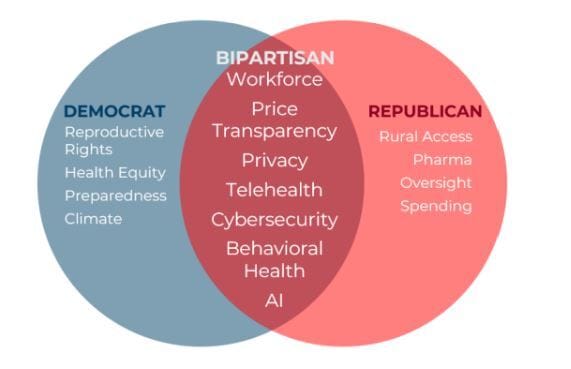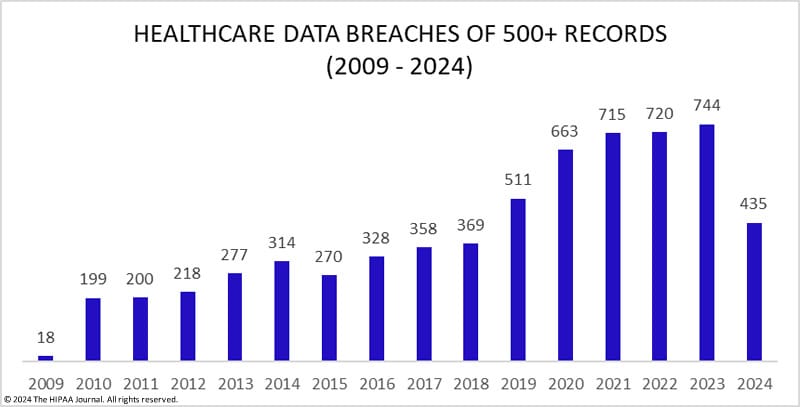- Trends
- Posts
- What The Looming Election Means For Healthcare Providers
What The Looming Election Means For Healthcare Providers
There are 68 days to go until a pivotal election day
Election season is upon is, and this year’s result will have impacts on every sector of the economy, from finance to agriculture… And healthcare, in a big way.
Federal Elections: President and Congress
First, a quick recap on where we stand today. Going into November, Democrats control the Senate and Republicans control the House. Biden obviously controls the White House.
The most probable scenarios are that a party split is maintained, with a chance that Republicans hanging on to a realistic possibility that they could pick up the Senate in addition to keeping the House. There really isn’t a scenario where Democrats take over both chambers.
A divided congress, or a congress that is on the opposing side from the President, will mean more slow, incremental moves on Capitol Hill. Funding for key healthcare initiatives in CMS, the NIH, and other programs that touch providers will move at a snail’s pace, and no fast or sweeping changes would be expected.
A Republican House and Senate - still a possibility - could mean a few things for providers, especially if Republicans also take the White House. You could expect more of a focus on spending and pharmaceutical oversight, along with prioritization of rural health initiatives.
A Democratic Senate and White House could work with the Republican House to make incremental moves in areas like health equity and disaster or disease preparedness. But as much as a Democratic President would want reproductive rights to be a priority, a Republican House would likely prevent any monumental legislation.
What is bipartisan? Quite a bit, actually, when it comes to healthcare. I would expect Veterans health funding, cybersecurity, price transparency, and healthcare AI all to be topics that get attention by the heads-down lawmakers who just want to get things done. They will wait until January to do much, though. For the fall, they are all back home, busy campaigning.

Presidential Platform Notes
For the sake of completeness, both Presidential candidates have platform planks that probably would have a hard time getting enacted, but they make for good campaign fodder.
Harris talks about erasing medical debts, expanding Medicare (but stopping short of Medicare for All), and further capping prescription drug prices, building on Biden’s work in that area.
Trump, meanwhile, talks about taking another run at repealing the Affordable Care Act, which he tried to do in his first presidency, and repealing parts of the Inflation Reduction Act which affect drug price caps. He says, however, he would want to deal with drug prices in different ways.
State Elections: What to Watch
A common mistake is to focus solely on the federal election - as interesting as it might be - and ignore the state elections. State outcomes can have a huge impact on health policy for those states.
There are 3 areas to watch, that will be impacted by the state elections:
M&A
State Attorneys General are very influential when it comes to healthcare M&A. Whether it is a merger of hospitals or health systems, acquisition of physician groups, or the entrance of a new non-local player in a market (remember when the Minnesota AG blocked the Sanford - Fairview deal?), and an Attorney General can set the M&A tone for four years.
Having more oversight of private equity or hedge fund transactions of healthcare facilities is also in the plans of some AG candidates, per their campaign statements.
Democratic AGs tend to be more restrictive on M&A, but there are many nuances based on the region and local political tones.
43 states have an elected Attorney General. The others have an appointment process, either from the Governor, Legislature, or Supreme Court.
Minimum Staffing Ratios
Nurse staffing ratios have been coming up more and more at the state level, with a few states passing laws or modified regulations that impact nurse staffing ratios. This obviously has a direct impact on providers and their care model - and associated costs. Most providers prefer the flexibility of determining their care model, versus having specific ratios mandated through legislation.
It tends to be an issue that is more on Democratic platforms than Republican agendas.
Four states currently have some form of direct nurse staffing ratios, and five more states had pending legislation on the subject during recent legislative sessions. It is an active issue.
Union Activity
Generally speaking, Democratic leaders are more favorable to unions than Republican leaders, by a ratio of 2-to-1. Democratic Governors and Legislatures tend to see more union activity. States like New York, Washington, and California have more unions, historically.
Union activity in healthcare has been on the uptick for the past five years or so.
Unions are not limited to nursing, but that is where most of the activity has been. They can also be found in support services and increasingly with employed physicians.
The union's’ agenda topics can vary, but this year I am seeing:
Minimum staffing ratios
Benefit or (to a lesser degree) pay increases
Working hour guardrails
Limiting AI deployment in specific areas
Other State-Level Issues to Watch
Other issues to watch in the state elections, depending on your locale, are campaigns’ emphasis of things data breach consequences, medical debt collection practices, and medical record access for reproductive and gender-affirming care rights.
Chart of the Month
I’m not saying I like this chart, but I found the data from the HIPAA Journal interesting.

The number of healthcare data breaches has climbed every year since 2015, and 2024 will of course be highlighted by the Change Healthcare cyber attack. If you are a provider and don’t have a continuous improvement imperative for cybersecurity, you should make it a priority for the rest of the year and beyond.